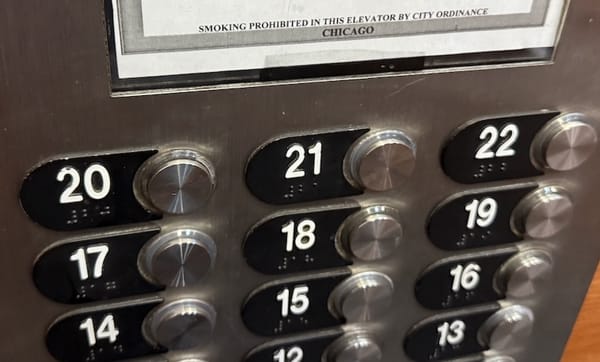I-(didn't)-GO: Why We Chose Zipcar
Though I don't drive, my boyfriend and workmates do. Tagging along through their experiences with Chicago's two car-sharing services, the for-profit Zipcar and nonprofit I-GO, it was easy to figure out which company offered the better customer-service experience. Hint: in the private sector, the cus

Sometimes it's hard to be a conservation-minded urbanist. Especially when you're faced with a choice between local car-sharing services I-GO and Zipcar. Such was the dilemma last week for Devyn, my annoyingly self-doubting, enormously gifted architectural photo-essayist boyfriend.
Devyn had a long history of car trips before we hooked up last year, and though I'm a committed transit user, it's not like I ever intend to visit, say, Ikea, on the RTA. (Having commuted to scum--er--Schaumburg from the city before for work, I know how sucky that trip is). So every now and then, when the idea of Swedish furniture, or the Indiana Dunes, or the Milwaukee Art Museum rears its head, we've tended to rent a car. But that gets expensive, and, especially downtown, you're at the mercy of the hours and locations of the few car rental firms that are nearby and open on weekends. Beyond Enterprise, those pickings are slim.
So we'd been toying with the idea of joining I-GO for awhile. Sponsored by the groovy, civic-minded, nonprofit Center for Neighborhood Technology, I-GO was the first car-sharing service to hit the streets of Hogtown. As with most car-sharing services, I-GO offers a flat membership fee, low hourly rates, and no hassles of additional insurance riders or filling up the gas tank on your own dime (insurance is included in membership fees and a company credit card is stowed in every car to pay for gas). It seemed too good to be true.
And for us, it was. When we actually compared I-GO to the new, for-profit national service, Zipcar, we were surprised to learn that the commercial service actually offered us a better deal.
Our only car trips tend to be medium-distance ones, out of the city, where transit fears to tread. Take Ikea. Fifty miles round-trip from our downtown abodes, a trip to the Swedish wonderland and back, with side trips and lunch thrown in, generally requires a car for six to eight hours. With I-GO's Standard plan ($6/hour + .50/mile), we would pay at least $60. The All Day plan with 200 free miles also would cost $60. The supposedly more attractive Standard Plus plan ($8.25/hour + .50/mile, with 25 free miles) would set us back at least $62. That's on top of a $75 membership fee and $25 annual maintenance fee. I-GO does offer frequent-driver plans, but those require membership fees of between $80 and a whopping $725.
Worse, your choice of car with I-GO is a Honda Civic. However, if you'd prefer, you can also rent a...Honda Civic. In fact, except for a few exceptions, I-GO's fleet is comprised almost exclusively of Honda Civics. The Civic-heavy fleet was apparently chosen due to the mileage benefits of the car. But in my book, although I-GO's cars are located all over the city, one choice is no choice at all.
Um, no sale.
With Zipcar's standard plan ($9/hour + .30/mile, with 125 free miles), that Ikea trip of ours would begin at $54. And unless we brought the car back late, it would stay there. True, other rates are a bit higher, with a $50 annual fee and a $66 daily rate. But Devyn and I were still left wondering why the free mileage offered by I-GO was so paltry compared to Zipcar. Essentially, the I-GO pricing penalizes you for actually using the car, at least for anything more than short trips--the trips you could probably make more cheaply in a taxi, anyway.
Moreover, Zipcar's higher incremental costs are more than made up for in one, screaming factor: choice. Zipcar offers one--a big one. Realizing that not all car trips are undertaken for the same reasons, Zipcar offers a variety of cars, from roomy, freight-hauling SUVs, to "coolness factor" cars like Minis and Mustangs, perfect for showing up in at that far-suburban high-school reunion. Right now, Zipcars are thinner on the ground than I-GO vehicles. But according to the Zipcar website, that will change as the for-profit company continues an aggressive local expansion strategy.
Now, obviously, I won't be driving any of these automobiles. I, as always, remain the ultimate car-sharer, unwavering in my lifelong intention never to learn how to drive, preferring to take transit or read the map for my significant other from the passenger seat. But if I'm going to be ferried about Chicagoland on special occasions in an automobile, I might as well do it (as might we all):
a.) in style; and
b.) on the cheap.
Fuel efficiency aside, there's something to be said about choice: you really ought to offer one. Devyn and I will be damned if I-GO expects us to plant our bearish butts into a boring old Honda Civic while paying a premium for the privelege. We're both big supporters of the environmental benefits of car sharing, which a membership in Zipcar still offers. We'd just rather pull up to Ikea in a Scion.
It's cooler. With Zipcar it's cheaper. And, let's face it, how much flat-packed Swedish furniture can you really fit in a Civic, anyway?




